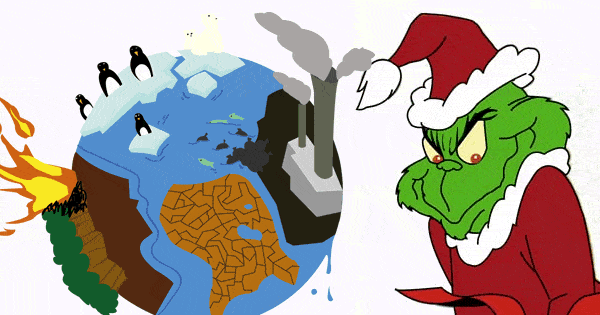Earlier this month, the world received some very welcome news that global CO2 emissions are projected to fall in 2015 – the first time this has ever happened while the global economy has grown. Assuming it’s accurate, the world mainly has China to thank for this early Christmas present. Unfortunately when it comes to our own backyard it’s bad news – when it comes to carbon emissions, New Zealand is determined to play the role of the Grinch this year.
Have global emissions peaked?
That’s the question on researchers’ minds in the wake of the surprising finding published in the peer-reviewed journal Nature Climate Change. The study – part of the Global Carbon Budget assessment conducted every year – found that global CO2 emissions are on track to fall by 0.6% in 2015 (with an uncertainty range of -1.6% to +0.5%). For comparison, the average annual emissions growth for the previous decade was +2.4%. 2014 displayed a major slowdown, with emissions growth slowing to just +0.6% in that year.
China is the main driver behind this year’s projected fall in global emissions, with a whopping 3.9% reduction. As we’ve blogged about before, structural changes in the Chinese economy are driving a rapid transition away from coal to clean energy. The USA’s emissions are also projected to fall by 1.5%, while India’s rapid growth continued

Sadly, it seems that global emissions probably haven’t peaked – with ongoing emissions growth anticipated in developing countries such as India, experts believe emissions will likely pick up again. But on the other hand, the result for this year has taken most by surprise. The change happening on the ground – especially in China – is outpacing expectations.
How’s New Zealand doing?
In another recent blog we showed how New Zealand’s CO2 emissions per person have increased since 1990, in contrast with most of the developed world. All up, our CO2 emissions increased 36% from 1990-2013. Remember, that’s leaving agricultural emissions (methane and nitrous oxide) entirely out of the picture. But how are we tracking in the last couple of years?
According to a government report released last week, New Zealand’s CO2 emissions fell slightly in 2014 (by about 1%), but are set to grow again by 2.1% in 2015. This all lines up well with other recent energy data we’ve analysed from MBIE’s website.
What’s driving our emissions increase?
Well yes – it seems the main driver is, in fact, driving.
Transport emissions have been steadily rising – up 2.6% in the first 9 months of this year according to MBIE data. Coal emissions are also up, perhaps driven by Fonterra using coal to make milk powder. Transport and heat are the part of our emissions our Prime Minister doesn’t like to dwell on – he prefers to focus on our high level of renewable electricity generation.
In recent years higher transport emissions have been hidden by falls in emissions from electricity generation – partly due to new geothermal plants and partly due to relatively good hydro years. This year so far, emissions from electricity generation have been roughly the same as last year, so the increase in other sectors is plain to see.
What about the future?
So to recap, we have been slack on emissions for the past 25 years, and 2015 is shaping up as no exception. While other countries toil to reduce emissions, we keep on burning fossil fuels like there is no tomorrow. And no wonder – while most developed countries have plans and policies in place to keep reducing their CO2 emissions, New Zealand has no such thing.
The report released last week shows that New Zealand’s CO2 emissions are officially projected to grow again in 2016 and 2017, before the anticipated closure of the Huntly coal power station knocks a bit of a chunk out. From then, CO2 emissions are projected to flat-line all the way out to 2030. These projections take account of all current policies, including a carbon price, which is assumed to rise. Is this really ‘doing our bit’ as the Government claims?

Limiting global warming to “well under 2°C”, as governments of the world all agreed to in Paris, requires rapid cuts in CO2 emissions. For a developed country like New Zealand to be planning on doing anything other than steadily cutting our CO2 emissions year-on-year is unacceptable. We know that’s doable. The latest data shows that the EU collectively reduced its emissions by over 5% in 2014, with several countries – the UK, Switzerland, France and Denmark – achieving massive cuts of around 9%.
Our Christmas present to the world
So while a lot of other countries have been nice this year and reduced their carbon emissions, New Zealand’s been naughty. Ours are set to rise by over 2% against a global decrease of 0.6%. True to tradition, we should expect a lump of coal in our Christmas stocking. But that would be unlikely to deter us – Fonterra would probably just use it to make milk powder…

